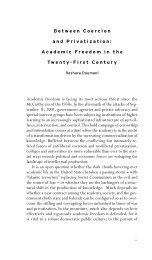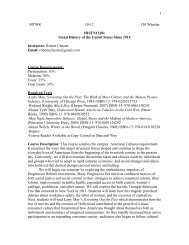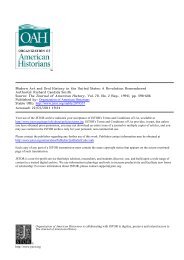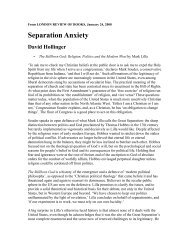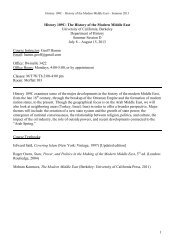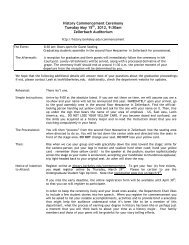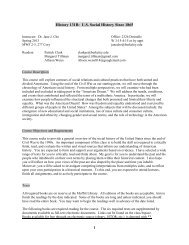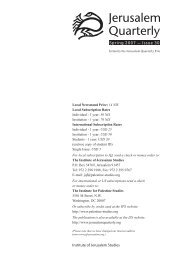David A. Hollinger | Amalgamation and Hypodescent: The Question ...
David A. Hollinger | Amalgamation and Hypodescent: The Question ...
David A. Hollinger | Amalgamation and Hypodescent: The Question ...
Create successful ePaper yourself
Turn your PDF publications into a flip-book with our unique Google optimized e-Paper software.
slaveholders <strong>and</strong> their allies regained control, <strong>and</strong> promptly reenacted <strong>and</strong> sharpened the slave era'sprohibitions on black-white marriage. 56<strong>The</strong> combination of hypodescent with the denial to blacks residing in many states with large black 36populations of any opportunity for legal marriage to whites ensured that the color line would longremain to a very large extent a property line. Hence the dynamics of race formation <strong>and</strong> the dynamicsof class formation were, in this most crucial of all American cases, largely the same. This is one of themost important truths about the history of the United States brought into sharper focus when that historyis viewed through the lens of the question of ethnoracial mixture.In the context of this truth, it cannot be repeated often enough that miscegenation law generally treated 37Latinos as white, <strong>and</strong> it was applied with little consistency to Indians <strong>and</strong> Asians. To be sure, marital<strong>and</strong> legal reproductive freedoms for Indians <strong>and</strong> Asian Americans were restricted in some states for anumber of years. But these restrictions did not perpetuate the social <strong>and</strong> economic conditions of slavery,<strong>and</strong> thus had a less profound effect on class position. Moreover, the bulk of the Latino <strong>and</strong> Asian-American population of the United States today are either immigrants or the children of immigrants, notthe descendants of families who were directly affected by the miscegenation laws of state governmentswithin the United States. To recognize these differences is not to obscure the injustice inflicted on nonblackdescent groups, which historians have amply documented. But it is to confront the peculiarcircumstances, duration, <strong>and</strong> class-consolidating consequences of anti-black racism. <strong>The</strong> power of thisparticular variety of racism to perform such extreme racialization <strong>and</strong> economic domination derivedfrom the fact that black people, <strong>and</strong> they alone, were overwhelmingly the descendants of men <strong>and</strong>women who had been pieces of property in the British colonies <strong>and</strong> in the United States, <strong>and</strong> that theseblack people, unlike immigrants of all colors, even those from Mexico, had little choice but to reside inthe country in which their ancestors had been enslaved, <strong>and</strong> that they, unlike Indians, carried nomystique of the new American Eden.Yet these differences in the historical experience of the several American minority descent groups 38sometimes have been hidden from view as we react in horror to the evils of white racism wholesale.This happened during the 1960s when the nation's system of anti-racist programs was organized <strong>and</strong>during the 1970s when these programs were consolidated <strong>and</strong> the political alliances supporting theseprograms were cemented. At those historical moments, significantly, almost nobody wanted to look atthe society <strong>and</strong> history of the United States through the lens of our question.Legal <strong>and</strong> educational initiatives primarily designed with African Americans in mind were extended 39to other historically disadvantaged ethnoracial minorities, implicitly color-coded as yellow, brown, <strong>and</strong>red. People in each of these color groups had been dreadfully mistreated, after all, <strong>and</strong> were still thevictims of prejudice in many contexts. It was convenient to apply to those groups the basic approachalready worked out for black Americans. As John D. Skrentny has shown, the assumption that this orthat group was "like blacks" drove the "minority rights revolution" in certain directions, while thefailure of the black analogy to gain credibility in relation to some other classes of well-mobilizeddisadvantaged persons limited the scope of that revolution. 57Although the decision to exp<strong>and</strong> the range of Affirmative Action beyond the black population was 40taken in the 1960s by government bureaucrats with little pressure from political organizations devotedto advancing the interests of Asian Americans, Latinos, <strong>and</strong> Indians, such organizations usuallywelcomed these expansions once effected, <strong>and</strong> in the 1970s they became forces behind the defense ofAffirmative Action programs. A conglomerate of minority advocacy organizations seemed like a goodpolitical investment. And at exactly the time that these lobby groups <strong>and</strong> the governmental <strong>and</strong>educational officials who responded to their concerns were acting, black Americans were asserting



